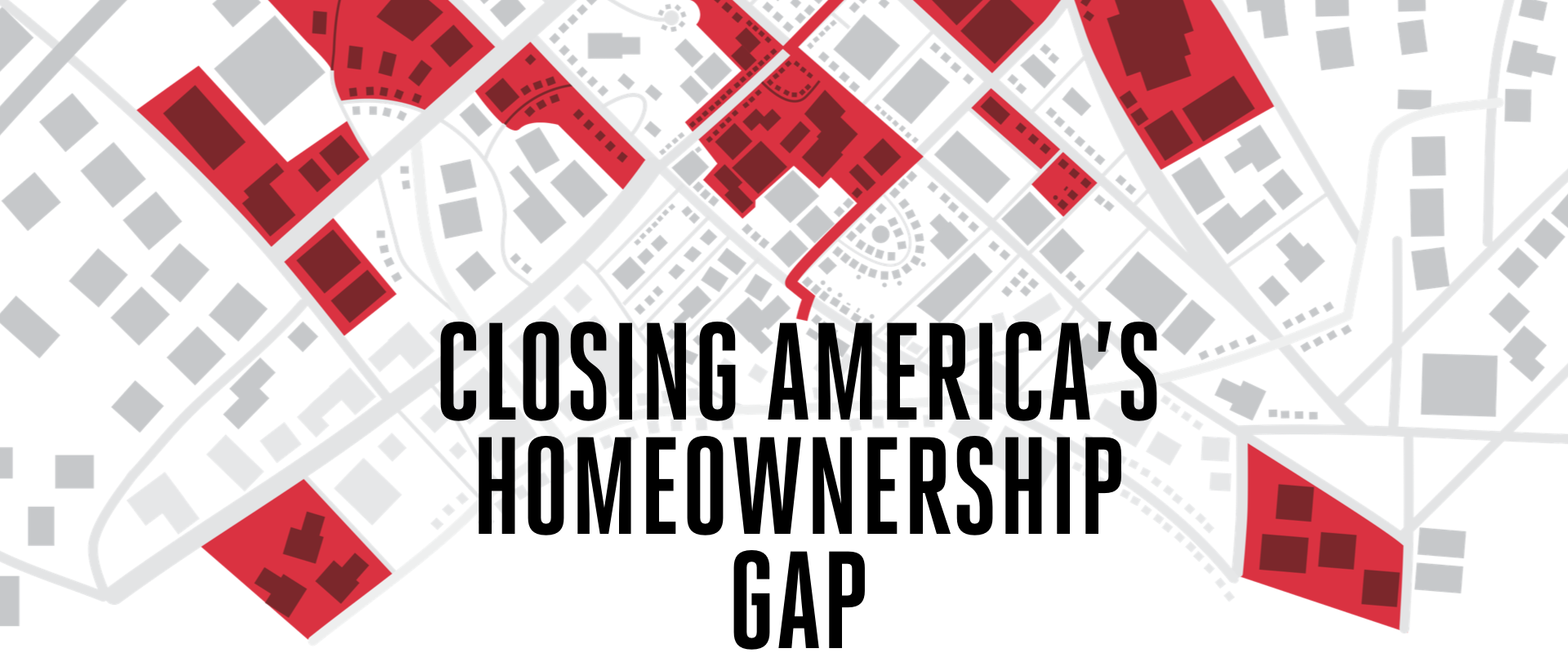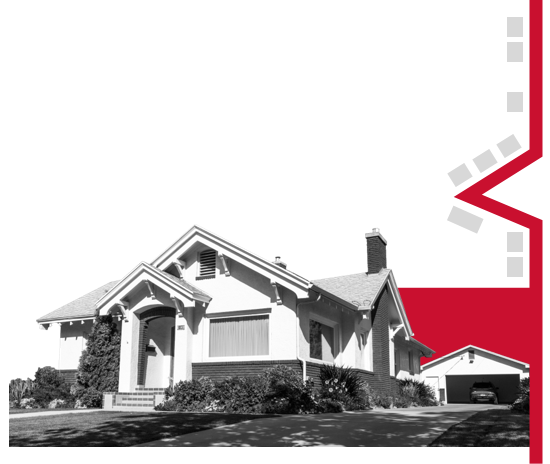Closing America's Homeownership Gap
Story // Sarah C.P. Williams
Boosting homeownership among Black people in America begins with owning up to a history of racial discrimination in the real estate and mortgage industries, say GW researchers studying the homeownership gap.
It has fueled the American Dream, inspired settlers to conquer new lands and motivated generations of young people to save a bit of each paycheck: the desire to own one’s own home. In recent years, homeownership rates have increased by record amounts, even as home prices surge faster than inflation. But not everyone is riding this wave.
The latest data from the U.S. Census Bureau shows that for nearly three-quarters of non-Hispanic white households in this country, homeownership is a reality. For Black Americans, however, it remains a dream for the majority; only 43 percent of Black households live in a home they own. This homeownership gap—a 30 percentage point difference between non-Hispanic white and Black homeownership rates—is as large as it has been in 120 years. It is also intrinsically linked to the growing wealth gap between Black and white Americans, says Vanessa Perry, a professor at the GW School of Business. White households have a median net worth at least 10 times that of Black households, according to a report she co-authored in 2020 for the National Association of Real Estate Brokers (NAREB).
“The wealth gap is really the homeownership gap,” she says. “We’re seeing young Black people who graduate from college and are able to get good jobs but are still falling behind their similarly situated white counterparts because their parents and grandparents weren’t homeowners and didn’t accumulate the same kind of wealth.”
of non-Hispanic white households that are homeowners
of Black households that are homeowners
It’s a Catch-22, of course. Those with the benefits of intergenerational wealth have the easiest path to becoming homeowners, which leads to more wealth. Perry wants to break that cycle—or at least give Black people a chance at joining it.
For decades, policymakers blamed the homeownership gap on other disparities—from education to employment. But improvements in these areas over the course of the 20th century barely moved the needle. Now, says Perry, it’s time for the country to face up to the much deeper roots of the gap: years of discrimination and exclusionary policies in the mortgage, housing finance, insurance and real estate industries that are still reverberating today.
“The solutions to the homeownership gap that have been tried so far haven’t worked because they haven’t addressed the underlying problems; they’ve skirted around them,” says Perry. “I hate to talk about reparations because people think it’s such a dirty word and shut down when they hear it, but at this point we need approaches that are directly enabling first-generation Black homeowners.”
Perry, who previously worked for the mortgage giant Freddie Mac, the U.S. Department of Housing and Urban Development (HUD) and the U.S. Consumer Financial Protection Bureau, now studies the homeownership gap. She and other researchers at GW use economic modeling, consumer research and public policy collaborations to probe the underlying causes of the gap, devise potential solutions to narrow it, and ask why—or whether—homeownership matters in the first place.
“I think academics have the freedom to ask bigger, bolder questions about the homeownership gap than a lot of economists working for agencies and banks,” says Janneke Ratcliffe, vice president of the Housing Finance Policy Center at the Urban Institute, where Perry is a visiting fellow. “Engaged scholars like [Perry] are in a position to really push the envelope for all of us on how we tackle these issues.”
“I hate to talk about reparations because people think it’s such a dirty word and shut down when they hear it, but at this point we need approaches that are directly enabling first-generation Black homeowners.”
VANESSA PERRY
Cumulative Disadvantage
President Franklin Roosevelt called real estate “about the safest investment in the world” and, in the midst of the Great Depression, established the Federal Housing Administration to revive mortgage lending—at least for white Americans. Mortgages remained still largely unobtainable for Black Americans, in part due to how lenders and agencies interpreted a set of maps that “redlined” Black neighborhoods across the country, categorizing them as risky investments.
Since then, numerous policies and initiatives have aimed to boost Black homeownership rates; most notably, the Fair Housing Act, signed into law in 1968, prohibited discrimination in the sale, rental and financing of housing.
Yet, in the NAREB-commissioned 2020 State of Housing in Black America report, Perry and her co-authors documented just how far the United States still is from meeting the goals of equity outlined in the Fair Housing Act. Black homeowners pay higher interest rates and higher insurance rates than white homeowners; their houses have lower values and appreciate more slowly. In an Urban Institute article published earlier this year, Perry and her colleagues calculated that Black mortgage applicants are more likely to be denied than white applicants—even Black applicants with incomes more than 150 percent of the area median income (AMI) have a higher denial rate than white applicants with incomes less than 80 percent of the AMI.
The denials aren’t generally fueled by overt discrimination, but rather by engrained practices in the mortgage industry that make it hard for Black Americans—with less intergenerational wealth, poorer credit scores and a lower debt-to-income ratio—to qualify. While only 18 percent of non-Hispanic white households have more than $40,000 in student loans, for instance, a third of Black households carry that much student loan debt.
“The way we measure risk does nothing but pass on historical discrimination and racism,” says Perry. “And so, to the extent we keep measuring risk in the same way, we’ll always be in a situation where Black and Hispanic home buyers have to pay more for mortgage loans.”
Even when humans are removed from the process—as mortgage companies increasingly turn to artificial intelligence-based tools to gauge credit risk—this kind of engrained historical discrimination cannot be easily removed from the equation, Perry says. New models of credit risk proposed by some researchers to take the weight off traditional measures of wealth have included a wide variety of data, from utility and rent payments to social media activity, GPS data, club membership and even school grades.
“But even these factors can be unknowingly correlated with race or with neighborhood,” says Perry. “So these new tools have to be really deeply looked at from a fairness perspective.”
Households with more than $40,000 in student loan debt:
18% non-Hispanic white
33% Black
30% gap between black and non-hispanic white home ownership rates
2.9 million
Black “mortgage-ready” households
Yet black mortgage applicants with incomes >150% of the area median income (AMI) have a higher denial rate than white applicants with incomes <80% of the AMI.
$46,000
home valuation gap between houses in mostly black areas compared with mostly white areas
97%
percentage of home appraisers who are white
Compared to non-hispanic white households, black households have:
Interest rates
Insurance premiums
Home valuations
27%
undervaluation of homes in Black neighborhoods
Source: NAREB-commissioned 2020 State of Housing
A Larger Set of Problems
When Black Americans do buy a home, they still face other barriers that can prevent them from accumulating wealth over time. For one, homeowners’ insurance tends to be harder to obtain and more expensive. In a Journal of Urban Affairs article, Gregory Squires, a GW professor of sociology and public policy and public administration who has long studied fair housing policies, concluded that racial profiling by the property insurance industry contributes to diminished opportunities for racial minorities. Even after controlling for other demographic factors, race is significantly associated with the availability and cost of insurance policies, he says.
Another problem revolves around appraisals. Home values in predominantly Black neighborhoods have historically been—and remain today—lower than those in predominantly white neighborhoods. It’s a cycle that is hard to break out of, since home appraisers rely on “comps,” or recently sold comparable properties, to set values. When one home receives a low appraisal, it then becomes a benchmark for the appraisal of nearby houses.
“When a property comes back with a very low appraisal, it suppresses the property value not just for the individual family but for the entire neighborhood,” says Squires, who has worked with HUD's Office for Fair Housing and Equal Opportunity. “It means the effects of yesterday’s and today’s discrimination keep persisting into the future.”
Appraisal bias—the undervaluation of homes owned by Black families or situated in predominantly Black neighborhoods—has received national attention in recent months. In March, the White House announced a plan to address home appraisal inequities. Squires is currently collaborating with the city of Philadelphia on a report about what local municipalities can do to solve appraisal bias.
Last year, the real estate brokerage Redfin crunched the numbers on 7.3 million home sales to conclude that homes in mostly Black areas are valued at about $46,000 less than comparable homes in mostly white areas. In Philadelphia, there is a 27 percent undervaluation of homes in Black neighborhoods, according to a paper Squires published last summer in the journal Poverty & Race. One driving factor? The vast majority of all home appraisers—97 percent, according to one White House report—are white. Increasing diversity in the appraisal, real estate and mortgage industries, Squires says, could help lessen appraisal bias.
“Sometimes there can be violation of civil rights laws even when there’s not a proven intent to discriminate.”
GREGORY SQUIRES
Benefits for All
Other economists argue that boosting minority homeownership alone cannot close the wealth gap; there are too many other factors correlated with long-term savings. Perry, however, notes there are research-backed benefits to homeownership—even aside from its potential for financial gain. Homeownership, she points out, affects the whole economy and benefits entire communities.
“Homeownership is connected to the ability for people to build equity, but there are also all these other benefits that can accrue almost immediately with increased homeownership rates,” says Perry. “You see improved public education and other public services. There’s more political participation.”
Stable housing can also bring health benefits. In 2021, Squires and Antwan Jones, an associate professor of sociology at GW, reported in the medical journal Circulation that cities with inclusionary zoning policies—which incentivize developers to set aside a share of new housing units for low- to moderate-income families—have lower rates of heart disease and other cardiovascular illness. “Stable, affordable housing in healthy communities can reduce stress and increase access to fresh produce, parks, jobs, safe streets and other amenities that help people stay healthy,” said Squires when the paper was published.
Today, housing prices continue to boom, rising nearly 20 percent between February 2021 and February 2022. Those rising prices help line the pockets of homeowners with additional equity while pricing non-homeowners out of the home buying market—again, a phenomenon that only exacerbates the racial homeownership gap.
“Our research would indicate that without a concerted effort, the homeownership gap is going to grow,” says Ratcliffe, speaking about data analyzed by the Urban Institute. “If we want to turn things around, we really have to stay deeply engaged.”
Perry is as engaged as ever, advocating for the lending and real estate industries to address the issues head on. “For a long time, people would just not address that historical discrimination and redlining were still underlying causes of the homeownership gap,” she says. Now, Perry says, lenders and policymakers are more aware of the continued and compounded role of this history, and the time is ripe for solutions.












